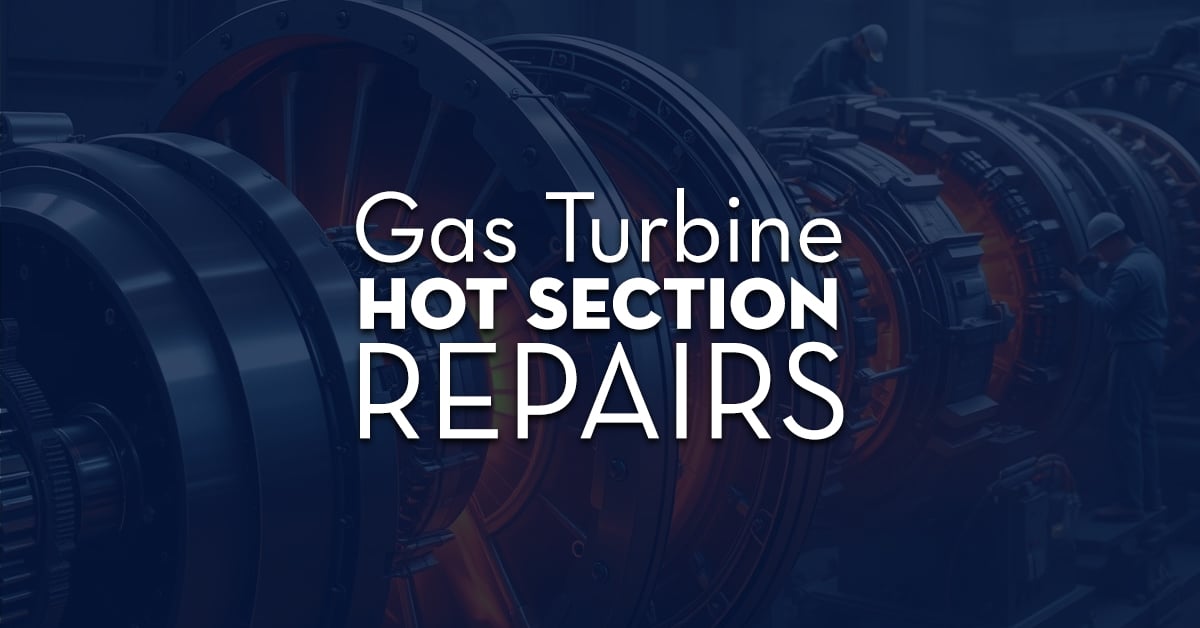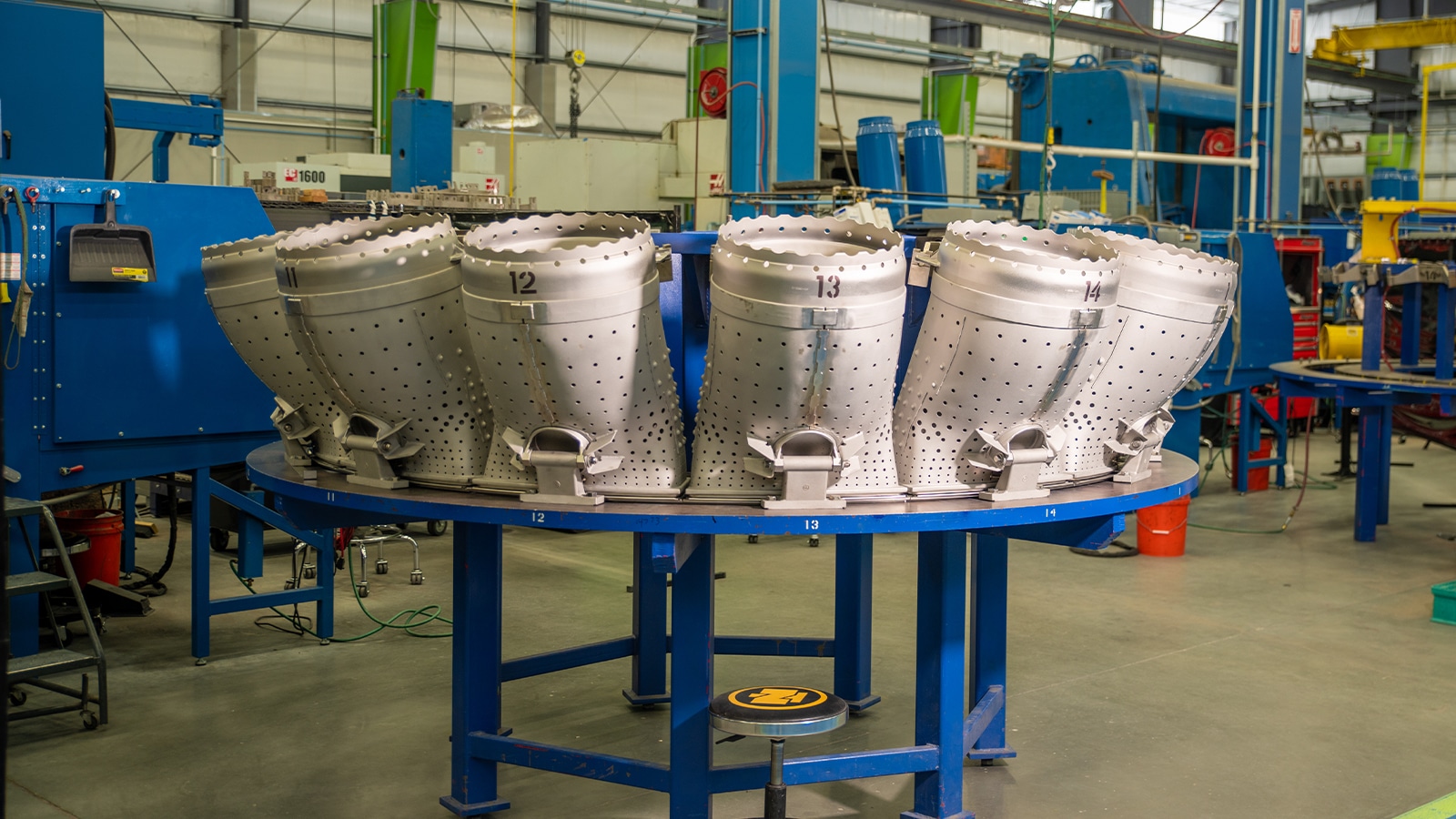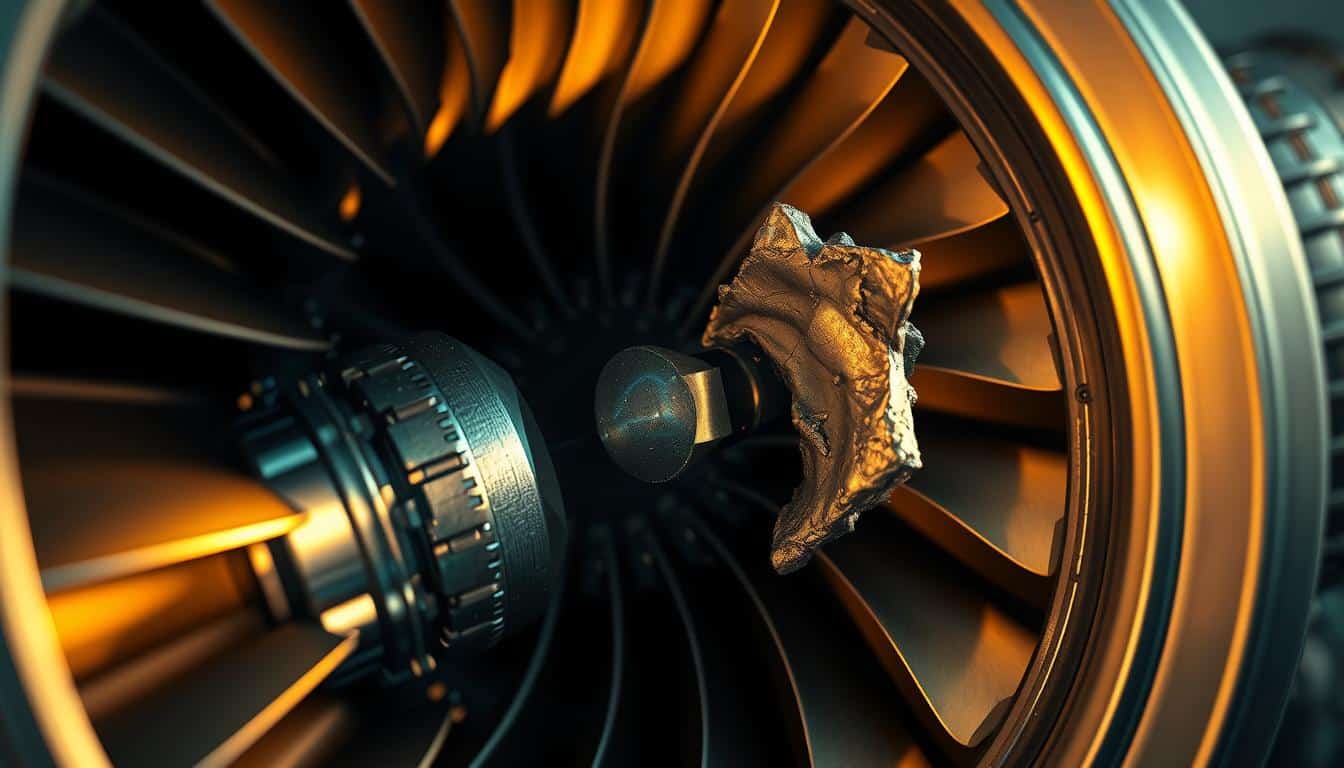
Gas turbine hot section repairs are critical for maintaining the optimal performance and reliability of turbine systems. The hot section, comprising gas turbine parts such as blades, vanes, and nozzles, operates under extreme temperatures and pressures. This makes it susceptible to wear, damage, and degradation over time. Timely and effective hot section repairs are essential to prevent unplanned downtime, improve efficiency, and extend the life of gas turbine assets.
Allied Power Group, a leading provider of advanced gas turbine repair services based in Houston, Texas, specializes in hot section repairs for various turbine models. This includes RB211, LM2500, and GE Frame-class turbines. Our certified technicians employ state-of-the-art techniques and processes to restore critical components to OEM specifications. This ensures maximum performance and durability.
By leveraging their expertise in turbine blade repair, component repairs, and advanced hot section repairs, Allied Power Group delivers reliable turbine services. These solutions minimize downtime and optimize the lifecycle value of gas turbine assets. Our approach addresses common failure mechanisms such as thermal fatigue, creep damage, oxidation, and hot corrosion. This restores the integrity and functionality of these critical components.
Key Takeaways
- Gas turbine hot section repairs are vital for maintaining optimal performance and reliability
- Allied Power Group offers expert hot section repair services for various turbine models
- Advanced repair techniques restore critical components to OEM specifications
- Timely repairs minimize downtime and extend the life of gas turbine assets
- Comprehensive approach addresses common failure mechanisms in hot section components
Understanding Gas Turbine Hot Sections
The hot section is a critical component of a gas turbine, playing a vital role in the turbine’s overall performance and efficiency. It is exposed to the highest temperatures and thermal stresses within the turbine, making it susceptible to damage and degradation over time. Understanding the components, operating conditions, and importance of the hot section is essential for effective maintenance and reliable turbine operation.
Components of the Hot Section
The hot section of a gas turbine consists of several key components that work together to convert the energy from the hot gas path into mechanical power. These components include:
- Turbine blades
- Nozzle guide vanes
- Turbine vanes
- Combustion liner
- Transition pieces
Operating Conditions and Thermal Stresses
The hot section components are subjected to extreme operating conditions, with temperatures often exceeding 1,000°C (1,832°F). These high temperatures, combined with the high-velocity gas flow, create significant thermal stresses on the components. The table below illustrates the typical operating conditions for various hot section components:
| Component | Temperature (°C) | Pressure (MPa) |
|---|---|---|
| Turbine Blades | 900-1,100 | 1.5-3.0 |
| Nozzle Guide Vanes | 1,000-1,200 | 1.5-3.0 |
| Combustion Liner | 1,200-1,400 | 1.0-2.0 |
Importance of Hot Section Integrity for Performance
Maintaining the integrity of the hot section components is essential for optimal gas turbine performance. Damage or degradation of these components can lead to reduced efficiency, increased fuel consumption, and safety hazards. Regular inspections, repairs, and replacements of hot section components are necessary to ensure reliable turbine operation and minimize downtime.
Learn more about our Gas Turbine Performance Upgrades.
Common Failure Mechanisms in Hot Sections
The hot section of a gas turbine faces extreme conditions, making its parts prone to various failures. These issues can cause performance drops, unplanned shutdowns, and expensive fixes. It’s vital to grasp these failure modes to craft effective maintenance and repair plans. This ensures the long-term reliability and performance of gas turbine hot sections.
Thermal Fatigue and Creep Damage
Thermal fatigue and creep damage are major concerns in gas turbine hot sections. Thermal fatigue arises from repeated temperature changes during start-up and shutdown. This stress cycling can cause cracks, mainly in high-stress areas. Creep damage, by contrast, results from prolonged exposure to high temperatures and stresses. It causes permanent deformation, leading to component failure. Regular inspections and timely repairs can help manage these issues.
Oxidation and Hot Corrosion Processes
Oxidation and hot corrosion are chemical failures that harm hot section materials. Oxidation forms oxide scales on components at high temperatures. These scales can flake off, exposing more material to oxidation. Hot corrosion, or sulfidation, is caused by contaminants like sulfur and vanadium in fuel or air. These react with materials, forming corrosive deposits that speed up degradation. Protective coatings and clean fuel can prevent these chemical failures.
Foreign Object Damage and Impact Wear
Foreign object damage (FOD) and impact wear are mechanical failures from ingested particles. These particles, like dust or debris, can hit components at high speeds, causing damage. FOD can lead to nicks, dents, or tears, increasing stress and crack risk. Impact wear results from repeated particle strikes, eroding material over time. Effective air filtration and regular inspections are key to preventing these mechanical failures.
Signs That Indicate Need for Gas Turbine Hot Section Repair
Gas turbine hot section components endure extreme conditions, including high temperatures and corrosive environments. Over time, these conditions can cause degradation, impacting performance and efficiency. It’s vital to recognize repair needs to maintain turbine operation and avoid costly failures.
Performance Degradation Indicators
A decline in performance is a key indicator for hot section repair needs. This decline may show as reduced power output, increased fuel consumption, or decreased efficiency. Monitoring parameters like exhaust gas temperature and compressor discharge pressure can help spot these trends.
Visual Inspection Findings
During routine maintenance, visual inspections can uncover wear, damage, or corrosion that requires repair. Common signs include cracks, erosion, discoloration, and distortion. Documenting these findings helps assess damage extent and necessary repairs.
Advanced Diagnostic Methods
Advanced diagnostics offer deeper insights into hot section component condition. These include borescope inspections, vibration analysis, thermography, and metallurgical analysis. These methods provide a detailed assessment, enabling targeted repairs and reducing downtime.
Preparation for Hot Section Repairs
Ensuring the success of gas turbine hot section repairs requires meticulous repair preparation. A detailed plan is essential, covering safety protocols, disassembly procedures, and documentation needs. Following industry best practices and maintaining strict quality control measures are key. These steps help mitigate risks and enhance repair outcomes.
Safety Protocols and Requirements
Setting up stringent safety protocols is the first step in hot section repair preparation. These protocols must include PPE, hazardous material handling, and emergency response plans. All repair personnel must undergo proper training and certification for high-temperature component work. Continuous safety audits and improvement efforts are vital for a strong safety culture.
Disassembly Procedures and Best Practices
Effective disassembly procedures are critical for hot section repair success. Technicians must adhere to manufacturer guidelines and industry best practices. This involves:
- Securing the turbine and isolating it from energy sources
- Removing outer casings and insulation materials carefully
- Disassembling hot section components in a specific sequence to avoid damage
- Labeling and organizing parts for inspection, cleaning, and repair
Following these best practices ensures components are not damaged and can be reassembled successfully after repairs.
Documentation and Component Tracking Systems
Implementing robust documentation and component tracking systems is vital. Each component should have a unique identifier, tracked through disassembly, inspection, repair, and reassembly. This system should include:
- Detailed photographs and condition reports
- Material specifications and repair history
- Inspection and testing results
- Repair procedures and quality control checks
Comprehensive documentation ensures traceability and accountability, providing valuable data for future maintenance planning and lifecycle cost analysis. Investing in detailed documentation and tracking systems streamlines repair processes, reduces errors, and improves quality control.
Advanced Inspection Techniques for Hot Section Components
To ensure the optimal performance and longevity of gas turbine hot section components, advanced inspection techniques are essential. These methods allow for thorough evaluation of the condition of critical parts. This enables targeted repairs and maintenance. By employing state-of-the-art inspection technologies, operators can minimize downtime, reduce costs, and enhance the reliability of their gas turbine assets.
Non-Destructive Testing Methods
Non-destructive testing (NDT) plays a critical role in assessing the integrity of hot section components without causing damage. Some commonly used NDT methods include:
- Fluorescent penetrant inspection (FPI): Detects surface defects such as cracks, porosity, and corrosion.
- Eddy current testing (ECT): Identifies surface and near-surface flaws, as well as changes in material properties.
- Radiography: Reveals internal defects, such as voids, inclusions, and wall thinning.
- Ultrasonic testing (UT): Detects both surface and subsurface flaws, and measures material thickness.
By combining multiple NDT methods, inspectors can obtain a detailed understanding of a component’s condition. This enables informed repair decisions.
Dimensional Inspection and Metrology Tools
Dimensional inspection and metrology are vital for ensuring that hot section components meet the required specifications. Advanced tools, such as coordinate measuring machines (CMMs), laser scanners, and optical comparators, enable precise measurements. These tools help identify wear, distortion, and other dimensional anomalies that may impact component performance and life.
Life Assessment Methodologies
Life assessment methodologies are used to estimate the remaining useful life of hot section components. These techniques consider factors such as operating history, material properties, and inspection findings. Some common life assessment approaches include:
| Methodology | Description |
|---|---|
| Creep life analysis | Evaluates the accumulation of creep damage over time |
| Low cycle fatigue (LCF) analysis | Assesses the impact of thermal and mechanical cycling |
| Oxidation and corrosion modeling | Predicts the extent of material degradation due to environmental factors |
| Fracture mechanics analysis | Determines the critical flaw size and remaining life based on crack growth rates |
By leveraging advanced inspection techniques, dimensional metrology, and life assessment methodologies, gas turbine operators can optimize their hot section maintenance strategies. This ensures the highest levels of reliability, efficiency, and cost-effectiveness.
Gas Turbine Hot Section Repair Techniques
Gas turbine hot section components face extreme temperatures, pressures, and harsh environments, leading to damage over time. Specialized repair techniques are used to restore these critical components and extend their service life. These processes aim to address specific failure mechanisms while ensuring the components meet stringent quality and performance standards.
Welding and Brazing Repair Processes
Welding and brazing are key repair techniques for gas turbine hot section component restoration. Tungsten Inert Gas (TIG) welding, also known as Gas Tungsten Arc Welding (GTAW), is commonly used for precision crack repairs and dimensional restoration. Laser welding offers high accuracy and minimal heat input, making it suitable for delicate repairs. Brazing, which involves joining materials using a filler metal with a lower melting point than the base materials, is often used for complex geometries and dissimilar material joints.
Thermal Spray Coating Applications
Thermal spray coatings are vital for protecting and restoring gas turbine hot section components. High Velocity Oxygen Fuel (HVOF) and plasma spraying are two primary thermal spray processes used in repair applications. HVOF coatings provide excellent wear and corrosion resistance, while plasma sprayed coatings offer thermal barrier protection and dimensional restoration. The choice of coating material and process depends on the specific component requirements and operating conditions.
Replacement vs. Repair Decision-Making Framework
Deciding whether to repair or replace a damaged hot section component requires careful consideration. A decision-making framework, such as the one shown below, helps evaluate the feasibility and cost-effectiveness of repair options:
| Factor | Repair | Replace |
|---|---|---|
| Extent of Damage | Minor to moderate | Severe or beyond repair limits |
| Remaining Useful Life | Sufficient for cost-effective repair | Limited, repair not economical |
| Cost Comparison | Lower than replacement | Higher than repair |
| Repair Process Availability | Proven repair techniques exist | No suitable repair process available |
Companies like Liburdi specialize in advanced repair techniques and proprietary processes, such as the Liburdi Powder Metallurgy (LPM®) process. This process can significantly extend the life of gas turbine components. By leveraging cutting-edge repair technologies and expertise, operators can optimize the performance and reliability of their gas turbine assets. This approach minimizes downtime and maintenance costs.
Cost Considerations and ROI of Hot Section Repairs
Costs and return on investment (ROI) are key in deciding on gas turbine hot section repairs. Evaluating these financial aspects ensures maintenance budgets are well-spent and downtime is reduced. By analyzing the lifecycle costs and repair economics, operators can make choices that boost profitability and save costs.
Lifecycle Cost Analysis
Lifecycle cost analysis is a powerful tool for assessing the long-term financial impact of hot section repair decisions. It considers initial costs, extended component life, and future maintenance needs. This approach helps identify the most cost-effective strategies for managing repair budgets. It justifies investments in high-quality repairs that offer lasting value and reduce total cost of ownership.
Downtime Minimization Strategies
Downtime is a significant cost driver in gas turbine operations, as lost production hours result in substantial revenue losses. To reduce the financial impact of hot section repairs, power plants can implement various strategies. These include maintaining spare components, optimizing repair turnaround times, and scheduling repairs during planned outages. By managing downtime effectively, operators can lower repair costs and maintain profitability.
Repair vs. Replace Economic Evaluation
When faced with damaged or degraded hot section components, power plant managers must decide between repair or replacement. This decision requires a detailed economic evaluation of both options. Factors to consider include repair feasibility, component condition, new part lead times, and overall repair costs. Advanced repair techniques can often restore components to like-new condition at a lower cost than replacement. Yet, for severely damaged or obsolete components, replacement may be the only viable option.
By analyzing cost considerations and ROI, gas turbine operators can make informed decisions about hot section repairs. Lifecycle cost analysis, downtime minimization strategies, and repair vs. replace evaluations are critical tools for navigating the complex economics of gas turbine maintenance. With a focus on cost savings and ROI, power plants can ensure their gas turbines operate reliably and efficiently for years.
Industry Standards and Regulatory Compliance
Gas turbine hot section repairs adhere to strict industry standards and regulatory compliance. This ensures safety, reliability, and performance. These standards guide repair processes, material selection, quality control, and documentation. They ensure repaired parts meet or exceed original specifications.
Following industry standards and regulations is critical for gas turbine hot section integrity. It minimizes failure or accident risks. Repair facilities must follow these guidelines and hold necessary certifications. This shows their dedication to quality and safety.
OEM Specifications and Requirements
Original Equipment Manufacturer (OEM) specifications are key for gas turbine hot section repairs. They outline approved repair processes, material selection, and quality control. Each OEM has its own design and tolerance requirements. Repair facilities must strictly follow OEM guidelines to ensure repaired parts meet design and performance standards.
ASME and API Standards for Repairs
The American Society of Mechanical Engineers (ASME) and the American Petroleum Institute (API) have set standards for gas turbine repairs. Standards like ASME BPVC and API 616 detail repair procedures, welding qualifications, and inspection methods. Following these standards ensures repairs are done according to industry best practices and meet quality and safety requirements.
Quality Management Systems and Documentation
Implementing a strong quality management system is vital for gas turbine repair facilities. Systems like ISO 9001 certification ensure consistent, controlled, and improved repair processes. Proper documentation, including repair procedures, material certifications, and inspection reports, is key. It proves compliance with industry standards and maintains accurate repair records.
Comprehensive repair documentation and certifications are essential for traceability and accountability. They help operators make informed decisions about their gas turbine assets. By focusing on quality management and documentation, repair facilities can provide reliable, high-quality repairs. These meet the demanding needs of the gas turbine industry.
Conclusion: Maximizing Gas Turbine Reliability Through Effective Hot Section Maintenance
To ensure optimal gas turbine reliability, a thorough hot section maintenance strategy is vital. Collaborating with experienced repair providers like Allied Power Group is key. They offer specialized repair expertise and advanced techniques to extend part life and cut downtime. Regular preventive maintenance, including inspections and timely repairs, helps spot issues early, preventing costly failures.
Effective hot section maintenance boosts gas turbine performance and profitability. By working with trusted repair solutions providers, operators can reduce downtime and optimize repair costs. This proactive approach ensures high reliability, making it a wise business investment for the long haul.
In conclusion, effective hot section maintenance is essential for maximizing gas turbine reliability. Operators must stay vigilant, use expert repair services, and adopt a proactive maintenance approach. This ensures gas turbines operate at peak performance and reliability for years. Partnering with leaders like Allied Power Group gives access to the latest repair technologies and expertise, keeping hot sections in prime condition.

